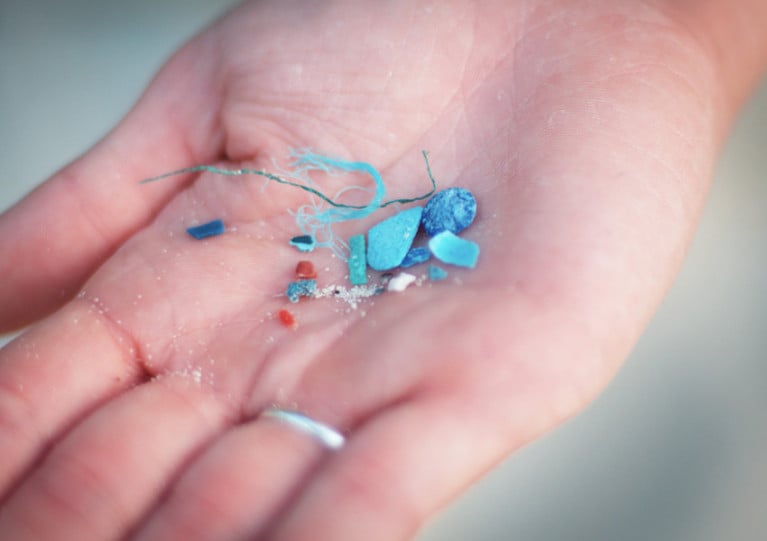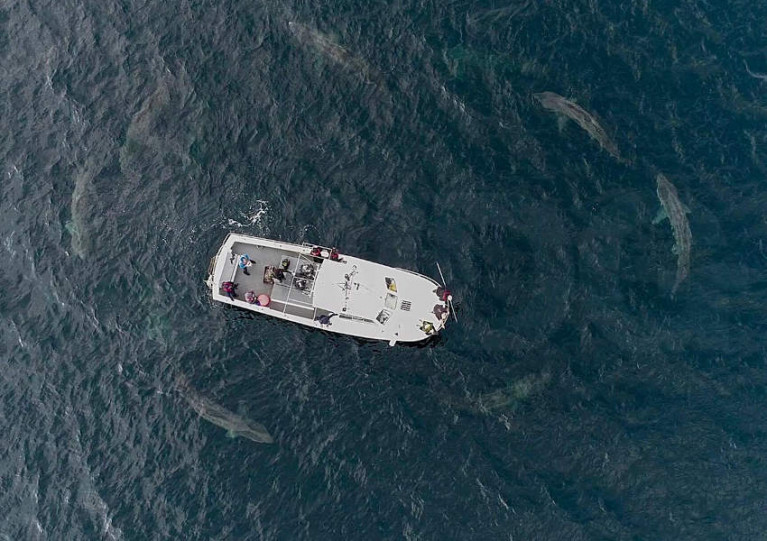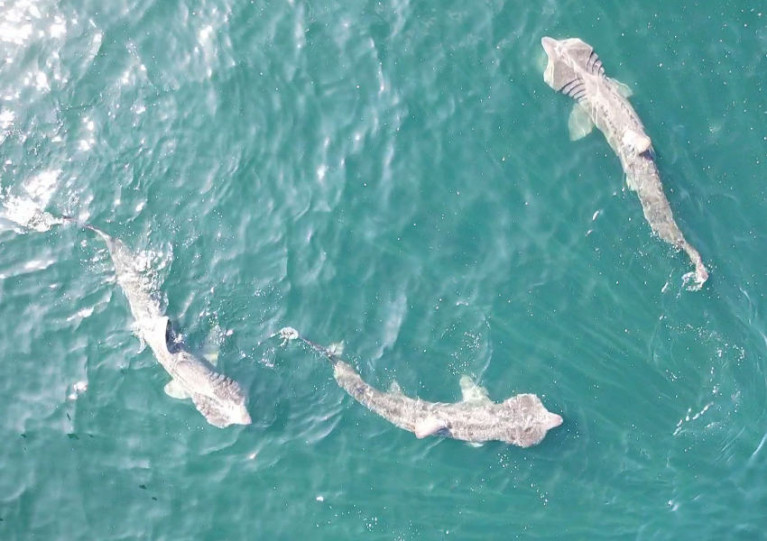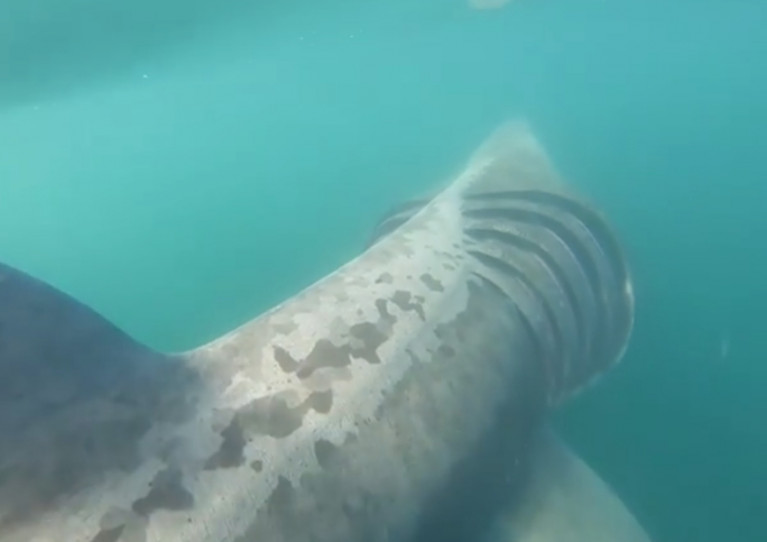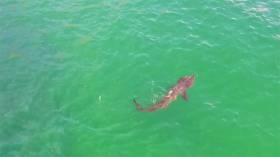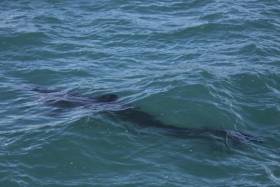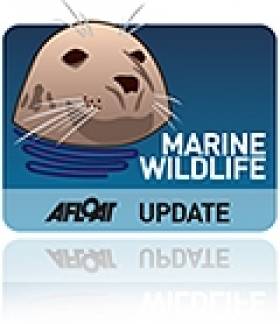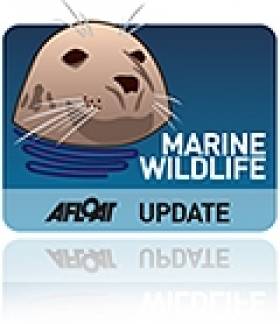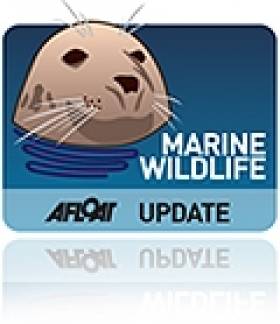Displaying items by tag: basking sharks
Next Tuesday 13 April the Cork Nature Network hosts a free talk in the impact of microplastics on the marine environment, and specifically on the largest fish in the sea.
During this talk, Dr Alina Wieczorek will be presenting her research — being conducted both in Ireland and the Maldives in the Indian Ocean — on microplastic interactions with whale sharks and basking sharks.
She will also share some first insights into how researchers can use scientific findings to inform society and stakeholders to collaboratively find solutions to address environmental issues such as plastic pollution.
Online attendance for ‘Microplastics a Macro-Disaster: A threat to the largest fish of our seas?’ at 7pm next Tuesday 13 April is free, and registration is open now at Eventbrite.
Rare Video Of ‘Courting’ Basking Sharks Captured By Drone Off Co Clare
Remarkable video of basking sharks engaging in what’s believed to be courtship behaviour has been captured by drone off Co Clare.
As RTÉ News reports, members of the Irish Basking Shark Group (IBSG) shot the footage of nine sharks swimming in a circle around their research boat last month.
Basking sharks, the world’s second largest fish species, are typically seen on the surface of Irish inshore waters in the spring, and rarely this late in the year.
“But we realised immediately that they were not feeding,” said Dr Simon Berrow, co-founder of the IBSG and chief executive of the Irish Whale and Dolphin Group (IWDG).
“This was something else, something special.”
The research team also took the opportunity to collect DNA samples from the massive marine wildlife, which which may reveal if they are genetically distinct from those big fish seen in the same waters earlier in the year.
How many basking sharks have reclaimed the waters off the South and West Coasts? “We don’t really know” is the honest answer from the Irish Whale and Dolphin Group.
But after a video of surfers in a close encounter with a school of the marine wildlife giants went viral last week, it’s become clear that the numbers — potentially into the thousands — are remarkable, if not unusual.
Getting a complete picture, however, “would require something like an aerial survey”, says IWDG sightings officer Pádraig Whooley.
In the meantime, their close proximity to the shore to feed on zooplankton presents “a fantastic opportunity for the members of the public to observe and record their observations to the IWDG, and thus make a real contribution to marine conservation”.
Filmed in Kilkee today. Wonderful to see so many together, they really seem to be making a comeback @BioDataCentre #baskingshark pic.twitter.com/aOLr72cuAK
— Hammy Hamilton (@CuilAodhaHammy) May 8, 2020
A surfing quartet got up close with a school of basking sharks off Co Clare at the weekend, as the Irish Examiner reports.
The surfers had brought a GoPro camera to video their wave-riding exploits, which came in handy to capture their encounter with as many as 20 of the giant marine wildlife on Saturday afternoon (2 May).
“They were quite slow and peaceful, and they just came towards us and cruised past,” says Tom Gillespie, one of the four and who recorded the footage.
“We just tried to make sure we didn’t look like plankton.”
The Irish Whale and Dolphin Group (IWDG) suggests that sightings of basking sharks in recent weeks indicate there could be “hundreds of animals” in a hotspot between Clare and the Aran Islands.
But while such large groupings are unusual, they are not unprecedented, according to the IWDG’s sightings officer Pádraig Whooley.
“As we are still less than mid-way through the shark season, it’s a little premature to be calling this a record year for sharks,” he said. “Better to wait till the end of the season when we can review all the sightings data and reflect on how good a season this has been the planet’s second biggest fish.”
Despite their fearsome size, basking sharks feed only on plankton and pose no threat to humans.
But that should not serve as any encouragement to take a dip while as social distancing measures remain in place.
One of the world’s largest sharks had become a regular visitor to an Achill Island beach, as Independent.ie reports.
Local tourist officials have recorded almost daily sightings of the 20-plus-foot basking shark in the waters of Keem Bay over the last month.
And has word of got out, visitor numbers on the Co Mayo island are growing among those hoping to get a glimpse of the gargantuan fish.
The second biggest fish in the seas behind the whale shark — and the largest in the North Atlantic — basking sharks are regulars in Irish waters.
Indeed, number of the gentle marine wildlife giants have reached such figures that experts have referred to the waters off the West Coast in the summer months as a ‘shark ark’.
Independent.ie has more on the story HERE.
Basking Sharks Spotted In Big Numbers Off Kilkee (video)
#BaskingSharks - Conservationist Andrew Power was in the right place at the right time on Monday morning (11 April) when he witnessed a group of up to 20 basking sharks feeding off Kilkee, Co Clare.
"You could see the inside of their huge mouths very clearly under the water as they were feeding," Power told RTÉ News of the three-hour breakfast. "They swam close to the rocks going in circles. It was incredible."
The Irish Whale and Dolphin Group (IWDG) reports that another sighting was made at the same time off Slea Head in Co Kerry – adding to a list of inshore sightings along the South West coast since 31 March, when the first basking shark spotting of 2016 was reported off West Cork.
Regular visitors to our shores, the second largest fish in the ocean were last seen in numbers back in September, as previously reported on Afloat.ie.
And the sheer size of this group is surely a boost for the 'shark park' initiative mooted for the Wild Atlantic Way last summer.
VIDEO: A close encounter with basking sharks off the Clare coast.https://t.co/d3ozNFg8RI
— RTÉ News (@rtenews) April 12, 2016
Humpback Wows Whale Watchers With Breach Off Baltimore
#MarineWildlife - Whale Watch West Cork have shared this incredible video of one of a humpback whale breaching off Baltimore this week.
The whale is one of three of the ocean giants seen feeding off Baltimore and nearby islands in recent days, and caught in some stunning shots by photographer Simon Duggan, among others.
Meanwhile, some no less impressive sights have been seen of Donegal, new video shows basking sharks - the second biggest fish in the sea - breaching off Malin Head.
Bren Whelan of Wild Atlantic Way Climbing told Independent Travel that it's been an "outstanding week" for marine wildlife watching on the North Coast, saying he himself had witnessed "over 300" basking shark breaches.
Basking sharks have been seen in big numbers the area all month long, with 15 spotted during the Irish Whale and Dolphin Group's Whale Watch Ireland 2015 event on the afternoon of 23 August alone.
'Shark Park' Could Be Big Draw For Wild Atlantic Way
#MarineWildlife - Ireland's basking shark visitors could be a big money-spinner for the Wild Atlantic Way, as Independent.ie's Travel TV reports.
The second largest fish in the sea are a regular summer sight off Ireland's coasts, particularly in Donegal, Mayo and Kerry – all prime spots along the western coastal tourism route initiative.
Indeed, Ireland is one of the best places in the world to see these magnificent examples of marine wildlife, says Emmett Johnston of the Irish Basking Shark Study Group.
And according to Dr Pete 'Hammerhead' Klimley, sites like Malin Head could be perfect as 'shark park' reserves to protect a species that may only number a few thousand worldwide, despite recently placing third in a list of the most unusual sharks.
Certainly such a shark park reserve would afford protections to help avoid the shocking harassment of marine life exhibited by two louts videoed 'surfing' a whale shark recently.
According to the Irish Mirror, calls have been made for the men involved in the sickening stunt to be charged for their abuse of the gentle giant, the largest fish in the world's oceans.
Video Shows Basking Shark On Patrol Off Dingle
#MarineWildlife - Following Friday's look back at the basking shark that surprised bathers off Cape Clear last summer, Independent.ie brings us this remarkable up-close video of the ocean giants returning to the Kerry coast for the warmer months.
The footage was captured near Dingle by sea kayaker Noel O'Leary, who said: "I’ve seen the odd minke whale, but to see a shark that's bigger than the kayak so close is quite amazing."
But it wasn't the only surprising sight around Ireland's coast as of late, as Her.ie reports on a 'surfing seal' in Dungarvan.
Apparently, the seal has become somewhat of a local celebrity after taking a liking to an abandoned surfboard at the mouth of the Colligan river.
Whether the cuddly sea dog is ready to take on the big waves of Mullaghmore remains to be seen!
First Basking Sharks Of 2015 Spotted Off West Cork
#MarineWildlife - The first basking shark sightings of 2015 were logged earlier this month, as Ireland's Wildlife reports.
Bridget Healy spotted two of the ocean's second-largest fish from the shore at Ardfield, near Clonakilty in West Cork last Monday 9 March – a little earlier than they usually appear.
But it's still some time off their peak numbers expected between May and June, when the gentle giants might come closer to the shore like one did in Cork Harbour last summer.
Ireland's Wildlife has more on the story HERE.


























